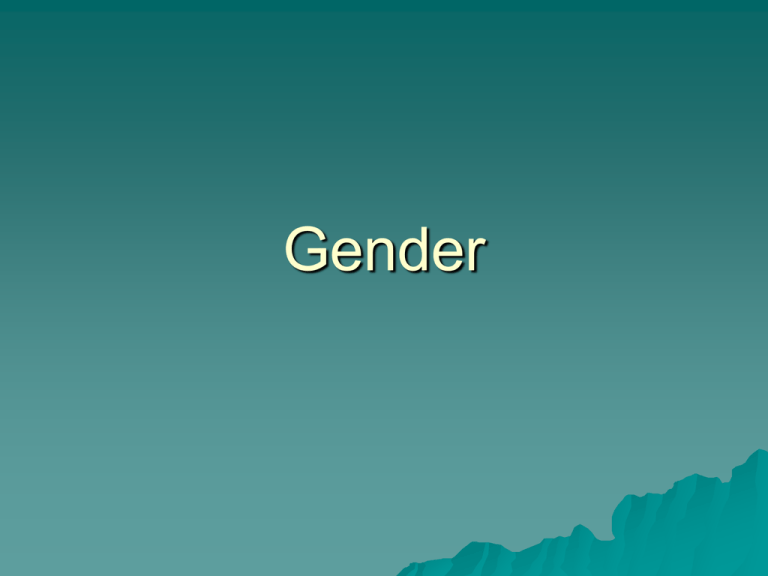
Gender
Gender
1930’s
Margaret Mead
– Is masculine/feminine idea of gender
universal?
– Three groups in New Guinea
– Gender patterned by culture
Sex and Gender
Sex
is biological
Gender is cultural
– Social, cultural, psychological
expectations a culture has of members
of each sex
– At least two sexes and genders,
sometimes more
Sex and Gender
Cultural
construction of gender
– 1970’s feminist anthropology studies
gender roles focusing on women’s lives
– History, impact of colonialism,
industrialization
Sex and Gender
Many
cultures recognize alternatives
– Nandi of Kenya, female husband
– Oman of Saudi Arabia, xanith
– Native American, two-spirit role
– Tahiti, mahu
– India, hijra
Cultural variation in sexual behavior
Acceptable
sexual behavior varies by
culture
What is erotic?
– Kissing
– sniffing(Tahitians)
– grooming(Trobrianders)
Cultural variation in sexual behavior
Acceptable
sexual behavior varies by
culture
Is homosexuality acceptable?
– Stigma
– Period of homosexuality part of process
of becoming a man (Sambia of New
Guinea)
Cultural variation in sexual behavior
Acceptable
sexual behavior varies by
culture
What role does sexuality play in
culture?
– The Irish of Inis Beag
Not
discussed, not mature until 40’s, little sex
– Polynesians of Mangaia
Sex
is private, but much public joking
Cultural variation in sexual behavior
Acceptable
sexual behavior varies by
culture
How does power influence sexuality?
– Covering the body, seclusion, honor and
shame
– Marriage, divorce, adultery controlled by
one part of society, church, colonial power
– Female circumcision (to control sexuality,
prove marriageability), Chinese
footbinding, sati (widow joins funeral pyre)
Rites of Passage
In
the US, adolescence is transition
between childhood and adulthood
In many cultures passage into
adulthood marked by ritual
– Announces transition to community
– Transmission of culture
– Reduces trauma of transition
Rites of Passage
Male
initiation
– Separation from family, often traumatic
and prolonged
– Often in cultures where boys have
strong connection with mother
Rites of Passage
Female
initiation
– May be public or private, long process
or quick ceremony
– Often in cultures where woman lives
with mother in adulthood
Gender Roles
A
culture’s expectations of men and
women
– What kind of jobs
– Personality traits
– Acceptable behavior
Gender Roles
Gender
hierarchy
– Ways in which gendered activities and
qualities are valued differently
– Different distribution of resources,
power, and prestige
Gender Roles
Private/public
dichotomy
– Gender system in which women have
low status because they are at home
with children while men are identified
with public, prestigious, political and
economic roles
Gender Relations - Foraging
Women
gather food and hunt
Tlingit, NW Coast
– Egalitarian gender relations
– Men and women equal access to status
by trade and by becoming a shaman
– Women held positions- head of clan
– History has carried on, today Tlingit
women hold high offices, are
encouraged to pursue education and
professional careers
Gender Relations - Horticultural
Wide
range of gender relationships
Segregation of sexes
– Men’s house, ritual, secrecy
– Women’s strong bonds to female kin
through shared work harvesting swamp
taro
Gender Relations - Horticultural
Example
of change over time –
Nukumanu, Polynesian atoll
– Horticulture and fishing, male and
female roles equally valued
– 1880’s colonialism, coconut production
commercial foods bought with wages
replaced taro that had been produced
by women
Gender Relations - Agricultural
Women
work more in home, raising
more children, status declines
Men produce product for market and
food for family, status increases
Gender Relations - Industrial
Use
of machinery and wage labor
often increases gender inequality
Gender Relations
Development
projects should
consider the impact on gender
relations
Do not want to create gender
inequality as this may increase
conflict within society








